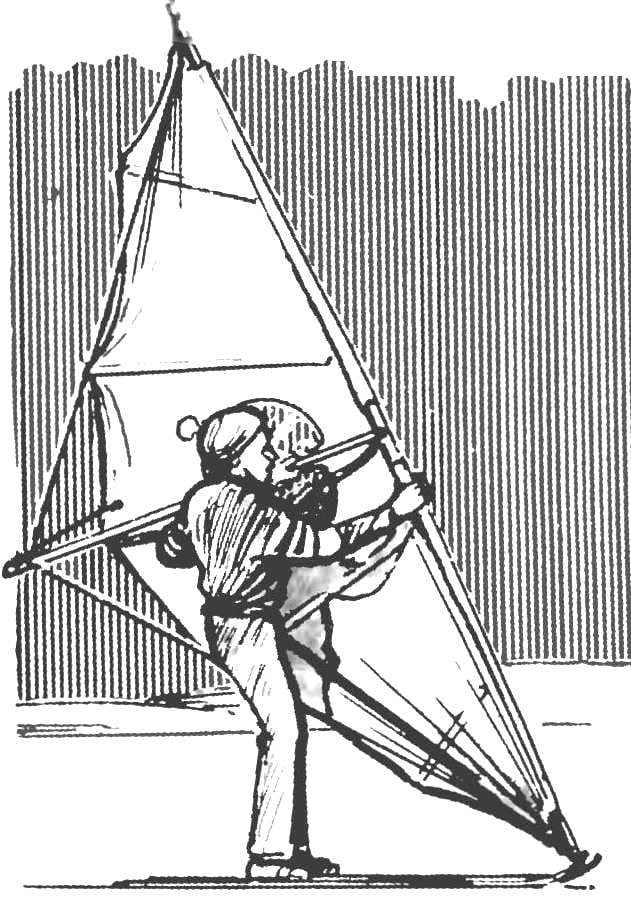It should be noted that the athlete, mastering the art of sailing on skis or on skates, then develops a sailing lighter Board and faster takes possession of equipment of management of small sailing vessels.
Now, let’s talk about the device “elliptical wing”.
The main element is the cloth of the sail. Foundation — strong, rigid mast and two nylon rope extending from the tack and head points of the angles to knock the boom-struts. To the mast, a curved back these ropes, the sail is attached by using a wide pocket fairing that eliminates the harmful effects of the masts to work the sails.
Changing the tension of the ropes, you can adjust the deflection of the mast and the magnitude and position of maximum width at the belly of the sail. The biggest hole is also adjustable with the help of a sheet, moves the sheet angle the sail along the boom. Under this system, the adjustment of the belly, and hard (almost straight) the mast of the sail approaches the surface of the cylinder. Middle, the widest part of the sail running at optimal angles of attack close to critical; closer to Galloway and top angles the angle of attack gradually decreases. Due to this decreases the inductive reactance of the sails with minimal loss of its overall thrust, which ultimately provides a significant increase in the speed of the skier when moving at sharp angles to the wind.
The sail is stretched on a mast at the bottom and top corners (galava and falavam) by means of ropes of stretch marks. When you rotate the sail 180° when changing tack flowy the angle becomes gulsevim and Vice versa.
The mast is made collapsible. In fact, two identical wood stud conical shape, connected by a segment of the dural tube Ø 40х1,5 mm. the Boom on the mast end of which also planted a duralumin pipe with a diameter of 40х1 5 mm with a cylindrical slot under the mast fastened to the mast М6х50 mm bolt and nut-“lamb” M6.
In the middle of the sail it is possible to sew a window of transparent film. To reduce sails in strong wind (slab) in the middle part sewn on both sides in small strips of sailing fabric stretches of nylon rope — RIF-starty.
To reduce the area of sail in front of the going to build around the mast and tied off with a reef-startime around her. Armor in this case are replaced by shorter ones.
To sail better “kept” aerodynamic shape, it is sewn lat-pockets in which to insert a thin wooden or plastic plate-armor.
At the thin ends of the mast and boom must be mounted on glue dural tube Ø 30х1,5 mm, in which drilled holes Ø 8 mm for the transaction of the Scots.
The corners sewn booty: two or three layers of the same fabric from which to sew a sail. In the corners of a sail, reinforced botami installed metal eyelets, through which the sheets, stretching the sail. In the absence of workpieces of metal eyelet holes in the corners of the sail can wrap thick nylon thread.
For sewing sails typically are used special fabrics, in extreme cases, they can replace percale (width 80 or 110 cm) or navolotsky tick (width 62 cm).
The dimensions of the sails, shown, is designed for a person with height 170 cm. With a smaller or larger increase the athlete’s overall height should change accordingly (it should be twice the growth).
Acute courses sail keep one hand on the mast and boom. On the wind — both hands on the boom: one at the mast, the other at a distance of 600-800 mm from the first.
 In the early 70-ies I happened to be a member of origin in the country of Windsurfing. In those years, sailing enthusiasts Board has high hopes for its extensive and widespread, but, unfortunately, a truly massive this sport did not, although the number of adherents of the sail increased significantly over the past two decades.
In the early 70-ies I happened to be a member of origin in the country of Windsurfing. In those years, sailing enthusiasts Board has high hopes for its extensive and widespread, but, unfortunately, a truly massive this sport did not, although the number of adherents of the sail increased significantly over the past two decades.
